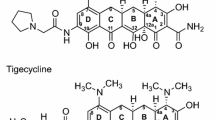Summary
The pharmacokinetics and tissue penetration of four quinolones were studied. The compounds were norfloxacin (400 mg p.o.), enoxacin (600 mg p.o. and 400 mg i.v.), ciprofloxacin (100 mg i.v. and 500 mg p.o.) and ofloxacin (600 mg p.o.) given to healthy volunteers. Of the oral agents studied ofloxacin and ciprofloxacin were the most rapidly absorbed (Tmax 1.2 h) and enoxacin the least (Tmax 1.9 h). The serum levels attained were highest in the case of ofloxacin (after allowing for the higher dose administered). The serum half-lives were norfloxacin 3.75 h, ciprofloxacin 3.9 h (p.o.), 4.0 h (i.v.), ofloxacin 7.0 h and enoxacin 6.2 h (p.o.) and 5.1 h (i.v.). All agents penetrated the blister fluid readily. The 24 h urine recovery (as measured by a microbiological assay) was 62% for enoxacin (p.o.), 46.4% following i.v. enoxacin (plus 11.6% oxo-enoxacin, measured by HPLC) 27% for norfloxacin, 30.6% for oral ciprofloxacin, 75.7% for i.v. ciprofloxacin and 73% for ofloxacin.
Zusammenfassung
Die Pharmakokinetik und Gewebepenetration von vier Chinolonen wurde bestimmt. Die untersuchten Verbindungen waren Norfloxacin (400 mg p.o.), Enoxacin (600 mg p.o. und 400 mg i.v.), Ciprofloxacin (100 mg i.v. und 500 mg p.o.) sowie Ofloxacin (600 mg p.o.). Die Untersuchungen wurden an gesunden freiwilligen Probanden durchgeführt. Von den untersuchten oralen Substanzen wurden Ofloxacin und Ciprofloxacin am schnellsten resorbiert (Tmax 1,2 Stunden) und Enoxacin am langsamsten (Tmax 1,9 Stunden). Ofloxacin erreichte die höchsten Serumspiegel (nach Gabe der höheren Dosis). Die Serumhalbwertszeiten betrugen für Norfloxacin 3,75 Stunden, für Ciprofloxacin 3,9 Stunden (p.o.), 4,0 Stunden (i.v.), für Ofloxacin 7,0 Stunden und für Enoxacin 6,2 Stunden (p.o.) und 5,1 Stunden (i.v.). Alle Substanzen penetrierten rasch in Hautblasenflüssigkeit. Die Wiederfindungsrate im 24-Stunden-Urin (gemessen mittels mikrobiologischem Assay) betrug für Enoxacin 62% (p.o.), 46,1% nach i.v.-Gabe (plus 11,6% Oxoenoxacin, bestimmt mittels HPLC) und für Norfloxacin 27%, für orales Ciprofloxacin 30,6%, für i.v. appliziertes Ciprofloxacin 75,7%, sowie für Ofloxacin 73%.
Similar content being viewed by others
Literature
Bauernfeind, A., Petermüller, C. In vitro activity of ciprofloxacin, norfloxacin and nalidixic acid. Eur. Clin. Microbiol. 2 (1983) 111–115.
Chartrand, S. A., Scribner, R. K., Weber, A. H., Welch, D. F., Marks, M. I. In vitro activity of CI-919 (AT-2266) an oral antipseudomonal compound. Antimicrobial Agents Chemother. 23 (1983) 658–663.
Chin, N-X, Neu, H. C. In vitro activity of enoxacin, a quinolone carboxylic acid, compared with those of norfloxacin, new β-lactams, aminoglycosides and trimethoprim. Antimicrobial Agents Chemother. 24 (1983) 754–763.
Nakamura, S., Nimami, A., Katae, H., Inouf, S., Yamagishi, J., Takase, Y., Shimizu, M. In vitro antibacterial properties of AT-2266, a new pyridone-carboxylic acid. Antimicrobial Agents Chemother. 23 (1983) 641–648.
Newson, S. W. B. The antimicrobial spectrum of norfloxacin. J. Antimicrobial Chemother. 13 Suppl. B (1984) 25–31.
Wise, R., Andrews, J. M., Danks, G. In vitro activity of enoxacin (CI-919), a new quinolone derivative, compared with that of other antimicrobial agents. J. Antimicrobial Chemother. 13 (1983) 237–244.
Wise, R., Andrews, J. M., Edwards, L. J. In vitro activity of Bay 09867, a new quinolone derivate, compared with those of other antimicrobial agents. Antimicrobial Agents Chemother. 23 (1983) 559–564.
Adhami, Z. N., Wise, R., Weston, D., Crump, B. The pharmacokinetics and tissue penetration of norfloxacin. J. Antimicrobial Chemother. 13 (1984) 87–92.
Lockley, M. R., Wise, R., Dent, J. The pharmacokinetics and tissue penetration of ofloxacin. J. Antimicrobial Chemother. 14 (1984) 647–652.
Shimada, J., Yamaji, T., Ueda, Y., Uchida, H., Kusajima, H., Irikura, T. Mechanism of renal excretion of AM-715, a new quinolonecarboxylic acid derivative, in rabbits, dogs and humans. Antimicrobial Agents Chemother. 23 (1983) 1–7.
Crump, B., Wise, R., Dent, J. The pharmacokinetics and tissue penetration of ciprofloxacin. Antimicrobial Agents Chemother. 24 (1983) 784–786.
Wise, R., Lockley, M. R., Dent, J., Webberly, M. Enoxacin: pharmacokinetics and tissue penetration. Antimicrobial Agents Chemother. 26 (1984) 17–19.
Mertz, N., Chang, T., Latts, J. R., Goulet, J. R., Yakatan, G. J.: Tolerance and bioavailability of CI-919 (AT 2266), a new antiinfective, in normal volunteers following single rising oral doses. 23rd ICAAC, Las Vegas, 1983, Abstract No. 858.
Osaki, T., Uchida, H., Irikura, T. Studies on metabolism of AM-715 in humans by high performance liquid chromatography. Chemotherapy (Japan) 29, Suppl. 4 (1981) 128–135.
Wise, R., Lockley, M. R., Webberly, M. J., Dent, J. Pharmacokinetics of intravenously administered ciprofloxacin. Antimicrobial Agents Chemother. 26 (1984) 208–210.
Author information
Authors and Affiliations
Rights and permissions
About this article
Cite this article
Wise, R., Lister, D., McNulty, C.A.M. et al. The comparative pharmacokinetics and tissue penetration of four quinolones including intravenously administered enoxacin. Infection 14 (Suppl 3), S196–S202 (1986). https://doi.org/10.1007/BF01667843
Issue Date:
DOI: https://doi.org/10.1007/BF01667843




